![]()
![]()
![]()
Use LEFT and RIGHT arrow keys to navigate between flashcards;
Use UP and DOWN arrow keys to flip the card;
H to show hint;
A reads text to speech;
103 Cards in this Set
- Front
- Back
|
reason horticulture is so important in California |
we have a horticultural lifestyle.
• produce 30% of US ornamental plants • consume 70% of US ornamental plants • spend 2x as much as the rest of the country on horticultural products |
|
|
2 major influences on the Southern California climate |
westerlies: predominant cool, wet winds flowing inland from the Pacific Ocean; low pressure
continental air mass: warm, dry, high-pressure air mass flowing from east to west |
|
|
4 factors affecting climate and weather in Southern California—interaction of these determines weather. |
1. distance from equator 2. elevation 3. westerlies 4. continental air masses |
|
|
causes of microclimate (climate within a climate) |
• topography: valleys; hills accumulating heat on S. & W. slopes • structures & hardscape • shade or full sun • soil type • bodies of water |
|
|
importance of microclimate (climate within a climate) |
determines which plants you can grow (plant selection)
You can't depend on big-box stores to stock plants appropriate for your zone & microclimate! |
|
|
Binomial nomenclature |
how we name plants; "two names".
formal system of naming species of living things by giving each a name composed of two parts, both of which use Latin grammatical forms; developed by Linnaeus
The first part of the name identifies the genus to which the species belongs; the second part identifies the species within the genus. |
|
|
Genus |
group of plants with similar flowering or reproductive characteristics
• 1st name in binomial nomenclature • always Capitalized • usually a noun |
|
|
species |
• 2nd word in binomial nomenclature • lowercase • adjective |
|
|
cultivar/horticultural variety |
• 3rd word in a plant name • bounded by single quotation marks • used for marketing • plant selected for desirable characteristics, usually propagated by cuttings |
|
|
Name the parts of this plant name: Carissa macrocarpa 'fancy' natal plum |
Genus, species, cultivar/horticultural variety, common name |
|
|
spermatophyta |
seed-bearing plants |
|
|
plant kingdom |
Plantae |
|
|
2 subdivisions of spermatophyta |
1. Gymnosperms 2. Angiosperms |
|
|
gymnosperms |
plants having a true seed, but not a true flower
• 3-17 cotyledons (princeton 2-24) • includes conifers, junipers, redwoods, etc. |
|
|
angiosperms |
plants having true seed and true flower
• include monocots (palm, grasses, bamboo) and dicots (most plants • include the large majority of land plants |
|
|
photosynthesis |
manufacture of carbohydrates in green plants.
green plants use solar energy to convert CO2, H2O, and minerals into organic compounds (primarily carbohydrates) and gaseous oxygen
CO2 + H20 —(chlorophyll, light)—► carbs + O2 |
|
|
respiration |
opposite of photosynthesis.
plants (and animals) convert carbs back into energy/heat for growth and other life processes
carbs + O2 —► CO2 + H2O |
|
|
location of photosynthesis in a plant |
in the chlorophyll; mostly in the leaves (97%), sometimes in green trunks |
|
|
location of respiration in a plant |
the entire plant or animal |
|
|
time when photosynthesis occurs |
primarily daytime, although a nighttime cycle is required as well |
|
|
time when respiration occurs |
24 hours a day |
|
|
ratio of photosynthesis vs. respiration required for optimum yield |
photosynthesis should be 8-10x respiration for optimum yield |
|
|
effect of photosynthesis on plant weight |
photosynthesis increases the weight of the plant |
|
|
effect of respiration on plant weight |
respiration decreases the weight of the plant |
|
|
summary of photosynthesis (6 points) |
• manufacture of carbs in plants • CO2 + H20 —(chlorophyll, light)—► carbs + O2 • occurs mostly in the leaves • utilizes solar energy • daytime, primarily • increases plant weight |
|
|
summary of respiration (6 points) |
• break down of carbs in plants & animals • carbs + O2 —► CO2 + H2O • occurs in the entire plant/animal • 24 hours • gives off heat • decreases plant weight |
|
|
function of root hairs |
absorb H2O in liquid form |
|
|
osmosis |
movement of H2O, nutrient and carbs from high concentration to low concentration via semi-permeable membranes |
|
|
transpiration |
daytime process where H2O vapor exits the leaf to cool the plant, and CO2 enters the leaf for photosynthesis |
|
|
effect of transpiration rate on photosynthesis |
when the transpiration rate increases, photosynthesis increases as well |
|
|
time when no transpiration is happening |
3-6am. This is the best time to water |
|
|
effect of transpiration exceeding absorption |
plant wilts |
|
|
deciduous |
plant that loses its leaves once a year |
|
|
annual |
plant that completes its vegetative cycle in one season, then dies |
|
|
biennial |
plant that completes its vegetative cycle one year, and its reproductive (fruiting) cycle the next year |
|
|
perennial |
plant that lives 3 or more years |
|
|
common name |
non-scientific name by which a species of plant is known. can vary by region |
|
|
monocot |
• single cotyledon in the seedling • flower parts in multiples of three • stem contains vascular bundles • stem has no cambium: girdling & deep planting will not kill • fibrous roots, replaced annually • parallel veination: marginal burn tip back • transplant in summer
|
|
|
dicot |
• 2 cotyledons in the seedling • flower parts in multiples of 4 or 5 • stem contains continuous vascular layers • stem has cambium: girdling & deep planting will kill • permanent root system; generally, taproot • net veination: marginal burn along edge • transplant when dormant
|
|
|
plants that are monocots |
• lilies • orchids • agaves • palms • grasses |
|
|
xylem |
conducts water & nutrients upward in the plant |
|
|
phloem |
conducts carbs downward in the plant |
|
|
cambium |
only place cell division occurs
• sends new phloem cells outward |
|
|
nutrient and growth cycle of a plant |
• H2O absorbed in root hairs • H2O moves upward cell to cell through the xylem by osmosis, from high concentration to low concentration, through semi-permeable membranes • H2O exits the leaf through transpiration; CO2 is diffused in the leaf at the same time • carbs created from CO2 + solar energy via photosynthesis • carbs move down the plant via the phloem
|
|
|
continuous vascular layers of a dicot stem, listed from outside to in |
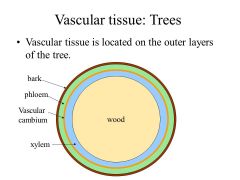
bark, phloem, cambium, xylem, pith
|
|
|
vascular bundles of a monocot stem |
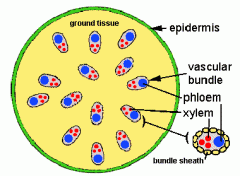
xylem and phloem, no cambium
(cambium is only in the apical meristem) |
|
|
simple leaf |

single leaf with a lateral bud at the base |
|
|
compound leaf |
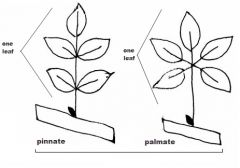
multi-leaf structure where there is a bud at the base of the petiole, but not at the base of the leaflets |
|
|
pinnately compound |
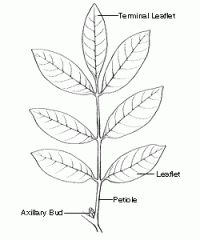
compound leaf where leaflets arise at several points along the petiole |
|
|
lateral bud |
undeveloped or embryonic shoot found in the axil of a leaf, on the side of a plant stem |
|
|
palmately compound |

compound leaf where leaflets arise from a single point along the petiole |
|
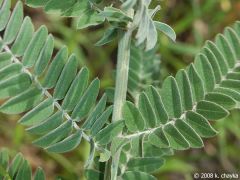
leaflet |
each of the leaflike structures that together make up a compound leaf |
|
|
bract |
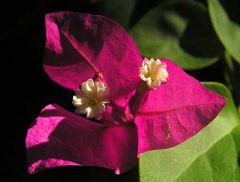
small, highly colored leaves that occur in the flowering parts (inflorescence) of a plant
• attract pollinators to plants with inconspicuous flowers |
|
|
stamen |
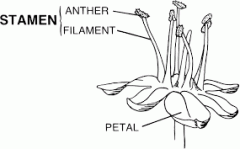
The male, pollen-producing part of a flower, usually a slender filament supporting the anther |
|
|
pistil |
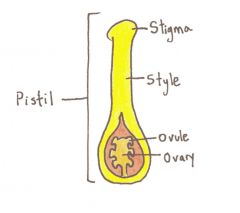
The female, ovule-producing part of a flower. Includes the stigma, style and ovary. |
|
|
anther |
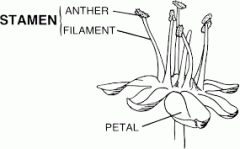
part of the flower that releases pollen |
|
|
stigma |

part of the flower that accepts pollen |
|
|
staminate |
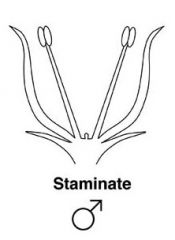
flower w/stamen, but no functional pistil
• male |
|
|
pistillate |
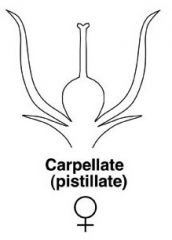
flower w/pistil, but no functional stamen
• female
|
|
|
hermaphrodite |
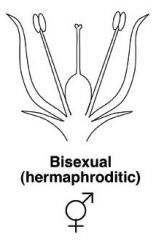
both functional male and female parts in the same flower
• most flowers are hermaphroditic |
|
|
monecious |
staminate flower and pistilate flower on the same plant, but not on the same portion of the plant |
|
|
dioecious |
functional male flower & plant is separate from a functional female flower & plant |
|
|
pollination |
transfer of pollen from anther to stigma
• no exchange of male and female genetic information |
|
|
2-step process of fertilization |
1. pollen (releases sperm) + ovary (releases egg) = zygote (seed) • seed can either be homozygous or heterozygous
2. pollen (releases sperm) + endosperm nuclei = endocarp (fruit) |
|
|
homozygous |
similar zygotes. plants from seed will be similar |
|
|
heterozygous |
variable zygotes. plants from seed will be highly variable |
|
|
parthenocarpic |
seedless fruit |
|
|
measurement of the intensity of light |
footcandles or lumens |
|
|
photoperiodism |
a plant's flowering or vegetative response to the duration of light
• can be thrown off by 25 foot candles of light |
|
|
short day plant |
plants that flower when they receive 6-8 hours of light
• can be manipuated |
|
|
long day plants |
plants that flower when they receive 10-12 hours of light
• can be manipulated |
|
|
day neutral |
duration of light has no effect on flowering |
|
|
nastic response |
plant opens or closes flowers or foliage at onset of darkness |
|
|
acclimation |
slowing down the photosynthesis of a plant by slowly reducing light, water & nutrients
• used to adjust a plant from greenhouse to indoor conditions
|
|
|
hardening off |
increasing photosynthesis of a young plant by slowly increasing light, water and nutrients
• opposite of acclimation • used to adjust young plants from greenhouse to outdoor conditions |
|
|
diurnal temperature fluctuation |
daytime temperature should be 5-20° higher than night |
|
|
growing season |
continuous days between the last frost in spring and the first frost in fall where the temperature is 32° or greater |
|
|
chilling requirement |
cumulative hours below 45°
• plants start storing carbohydrates 45° |
|
|
what happens when a plant's temperature reaches 45° or below |
the plant stops using carbs for growth and starts storing them |
|
|
relative size difference between sand and clay |
basketball vs. BB |
|
|
ideal soil composition |
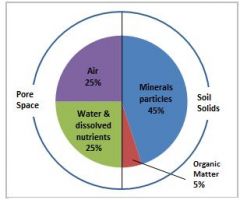
45% mineral 5% OM 25% air 25% H2O |
|
|
clay soils |
soils with more than 20% clay |
|
|
loam |
has sand, silt and clay particles
• usually less than 10% clay |
|
|
soil pH |
measure of soil acidity or alkalinity, on a scale of 1-14
• above 7: increasingly alkaline • below 7: increasingly acidic • most plants grow at pH 6-8 • scale is to a power of 10 (i.e. 8 is 10x more than 7) |
|
|
soil salinity |
salt content of the soil |
|
|
major source of salinity in Southern California |
water from the Colorado River |
|
|
how to treat high salinity in soil |
leaching, which is difficult in clay soil. wetting agent can be added to enhance leaching in clay soil |
|
|
efficacy of gypsum to treat high soil salinity |
works, but takes 5-7 years to work |
|
|
list 6 soil amendments, and the advantage or disadvantage of each |
sawdust: too fine; compacts the clay particle pine shavings: only last 6 months redwood: lasts 5 years biosolids: contain nitrogen-fixing bacteria perlite: doesn't compress vermiculite: compresses
|
|
|
2 effects of nitrogen (N) on plants |
• makes them green • helps vegetative growth |
|
|
nitrogen cycle |
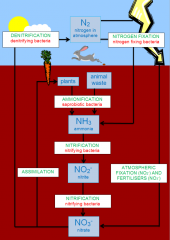
process where organic nitrogen is broken down by soil bacteria into forms available for plant uptake (nitrate)
organic N → ammonia (NH3)→ nitrite (NO2) → nitrate (NO3) |
|
|
response rate of the plant when nitrogen is added |
fast |
|
|
4 effects of phosphorus (P) on a plant |
• enhances flower & fruit set • root development • cold-hardiness • hastens maturity |
|
|
bone meal as phosphorus source |
• must be in contact with the roots • 5-7 years to absorb |
|
|
preferred source of phosphorus |
superphosphate (mined rock) |
|
|
3 effects of potassium (K) on a plant |
• balances uptake of other nutrients • reduces summer stress • increases disease resistance |
|
|
muriate as potassium source |
contains chloride, which is toxic to plants |
|
|
pallor vs. chlorosis |
pallor: whole plant yellows N deficiency
chlorosis: veins stay green, areas between yellow can be caused by iron deficiency |
|
|
reason iron and magnesium may not be available to the plant, even when they're present in the soil |
elemental iron becomes unavailable to the plant as soil pH rises above 7 (soil too alkaline) |
|
|
form of iron whose absorption isn't affected by soil pH |
chelated iron |
|
|
3 numbers that always appear on a fertilizer bag, and what they represent |
minimum percentage of the nutrients nitrogen, phosphorus and potassium, respectively, present in the fertilizer
(N-P-K) |
|
|
guaranteed analysis |
manufacturer must disclose the minimum percentage of N, P & K in the fertilizer, as well as the specifics of which fertilizer carriers (materials carrying the plant nutrients) are being used |
|
|
list 3 slow-release fertilizers and briefly describe how each works |
1. Osmocote: resin-coated osmotic slow-release fertilizer. releases via osmosis (semi-permeable membrane, high concentration → low concentration) when nutrients are absent 2. Agriform: needs soil bacteria (and ∴ 45°+) to break down. fertilizer particle size and bacterial activity determine release speed. 3. IBDU: release rate determined by size of particle and level of soil moisture |

